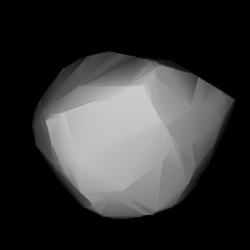Astronomy:681 Gorgo
From HandWiki
 Modelled shape of Gorgo from its lightcurve | |
| Discovery | |
|---|---|
| Discovered by | August Kopff |
| Discovery site | Heidelberg |
| Discovery date | 13 May 1909 |
| Designations | |
| (681) Gorgo | |
| Pronunciation | /ˈɡɔːrɡoʊ/ |
| 1909 GZ | |
| Orbital characteristics[1] | |
| Epoch 31 July 2016 (JD 2457600.5) | |
| Uncertainty parameter 0 | |
| Observation arc | 83.58 yr (30526 d) |
| |{{{apsis}}}|helion}} | 3.4247 astronomical unit|AU (512.33 Gm) |
| |{{{apsis}}}|helion}} | 2.7859 AU (416.76 Gm) |
| 3.1053 AU (464.55 Gm) | |
| Eccentricity | 0.10287 |
| Orbital period | 5.47 yr (1998.7 d) |
| Mean anomaly | 145.868° |
| Mean motion | 0° 10m 48.396s / day |
| Inclination | 12.580° |
| Longitude of ascending node | 177.985° |
| 117.024° | |
| Physical characteristics | |
| Rotation period | 6.4606 h (0.26919 d) |
| Absolute magnitude (H) | 10.8 |
681 Gorgo is a minor planet orbiting the Sun.
'Gorgo' is German for Gorgon. However, Ingrid van Houten-Groeneveld and Antonio Paluzie-Borrell suggest it may refer to "King of Salamine, in the 5th century B.C., who accompanied Xerxes in Greece."[2]
References
- ↑ "681 Gorgo (1909 GZ)". JPL Small-Body Database. NASA/Jet Propulsion Laboratory. https://ssd.jpl.nasa.gov/sbdb.cgi?sstr=681;cad=1.
- ↑ Schmadel, Lutz D. (2007). "(681) Gorgo". Dictionary of Minor Planet Names – (681) Gorgo. Springer Berlin Heidelberg. p. 73. doi:10.1007/978-3-540-29925-7_771. ISBN 978-3-540-00238-3.
External links
- 681 Gorgo at AstDyS-2, Asteroids—Dynamic Site
- 681 Gorgo at the JPL Small-Body Database
 |

